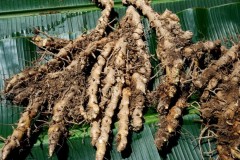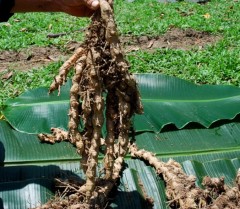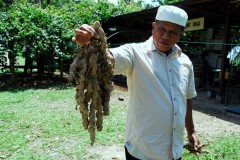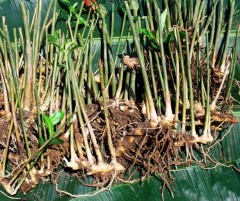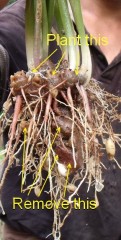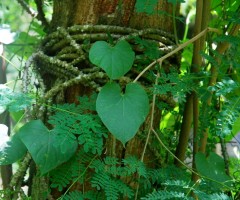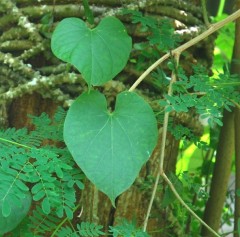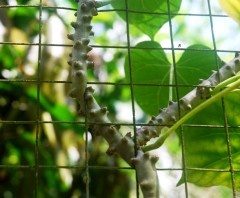Apr 17, 2013
Useful Plants At The Farm - Sirihan, Piper Aduncum / Angustifolium
The early European explorers to South America must have thought this plant is so important they propagated it where ever they went. It is now found naturalised in most tropical parts of the world.
At our farm it is a valuable part of the natural remedies we have for our chickens.
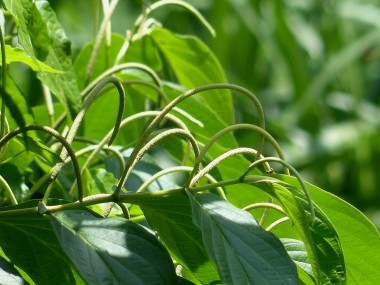
The inflorescence attracts squirrels, tree shrews and civets.
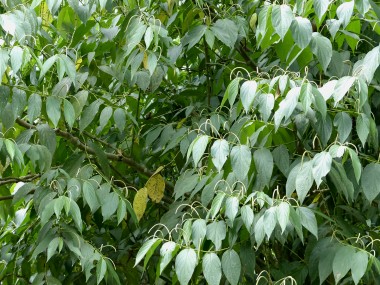
Like its cousin the green pepper vine, lots and lots of inflorescence.

In the fields, they provide shade for the chickens but be careful, they are very invasive and will take over the entire padang!
Here's the technical information : Rain-Tree.com
Crush the leaves. If it has a slight peppery smell, you have the sirihan in your farm. Use it by pounding the leaves and squeezing out in a pail of water, or by decoction. Dosage is dependent on age and symptom.
12:02 Posted in Nature Farming, Sustainable Farming, Useful Plants | Permalink | Comments (0) | Tags: sirihan, piper aduncum, piper angustifolium, natural remedies for chickens
Jun 20, 2012
Useful Plants At The Farm - Lemba
Lemba or curculigo latifolia is native to Malaysia. We grow them at the farm to preserve them.
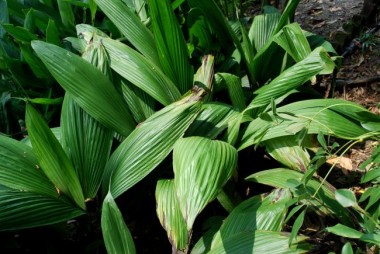
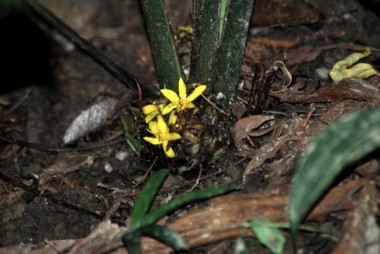
It has tiny, bright yellow flowers
They have fibers that can be used to make ropes and textiles.
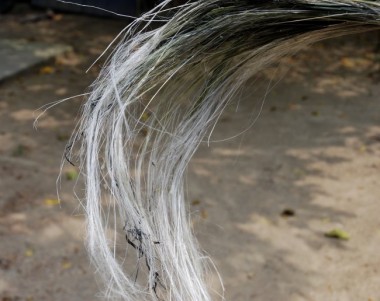
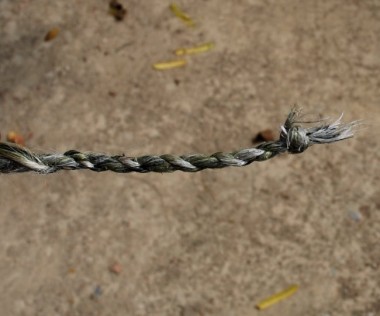
A rope made from the fibre. Strong enough for farm use.

The Ibans use the fibre to make a textile called 'pua'
And most importantly, they have a taste-modifying protein which changes plain water and sour drinks to sweet. Japanese researchers have patented the protein.
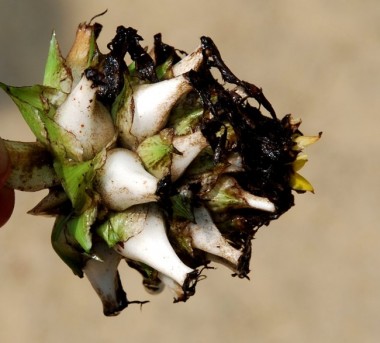
Bunch of lemba fruits

The tiny taste-modifying fruits
Foreign researchers coming into Malaysia should be required to sign an agreement to share patent-rights and commercial benefits with the people of Malaysia as represented by the Government.
It is ridiculous and maddening to hear foreign researchers write that they have discovered that the plant can modify the taste of sour drinks to sweet when it is most likely the case that the local people told them about the plant and it is something the local people have known for generations.
We have numerous emails, some frenetic, wanting this herb and that herb etc. from researchers local and foreign. I am sorry, I won't even bother to answer your email unless at the outset you declare that all research findings, etc will be shared, and in the event of patents, commercial profits, etc., to be share with an institution of our choosing.
12:04 Posted in Useful Plants | Permalink | Comments (0) | Tags: lemba, curculigo latifolia, curculin, artificial sweetener, natural sweetener, taste-modifying protein
Mar 20, 2012
Interesting Trees At The Farm - II
One of my favourite fruits is the Nam Nam, or katak puru (toad).
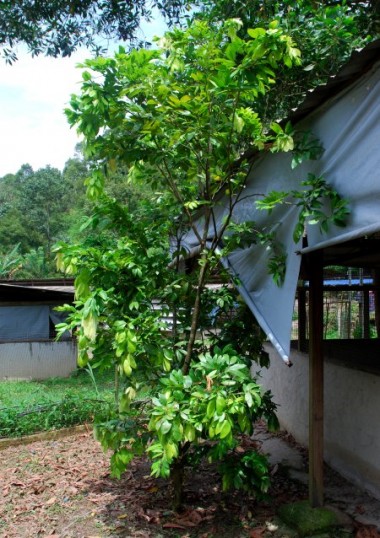
It’s a short shrubby tree, and really quite pleasing to the eye. I can picture it potted in a large pot and acting as a centre piece in a home garden.
The fruits grow on the tree trunk itself; how's that for a conversation piece!
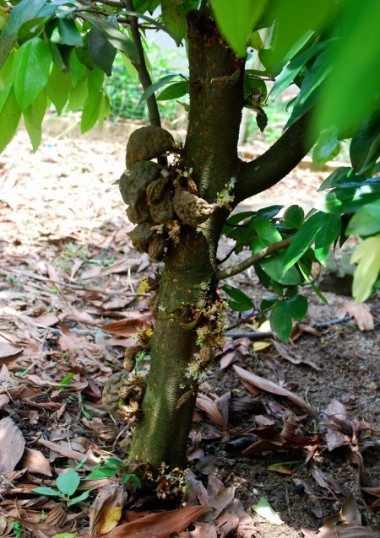
All you need to do is stoop down and pluck off ripe ones.
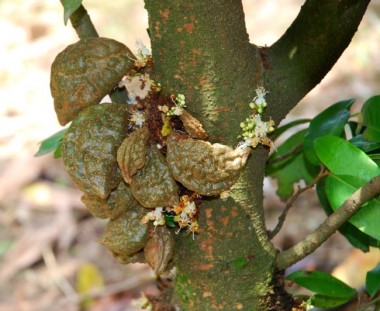
A cluster of fruits
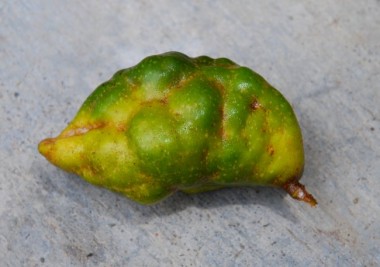
A ripe fruit
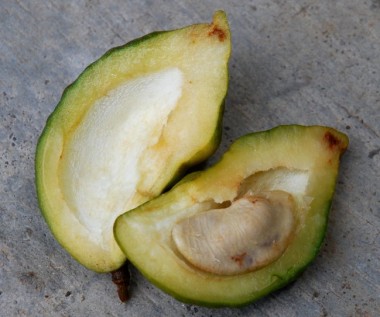
The inside of the fruit.
I like to munch it raw with skin intact. It is tart, sour, sweet, fragrant and crunchy when freshly plucked from the tree. Wait a day, and it looses its crunchiness. Kampung (village) folks say both the fruits, and the leaves made into a tea, aids in relieving kidney stones, diabetes and high blood pressure.
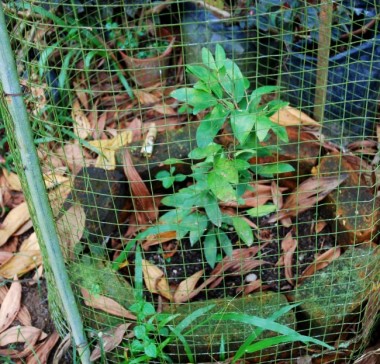
It is easily marcotted / air layered, and almost always survives planting. Nam Nam grown from seeds takes up to 6 years to fruit. I believe marcotted ones should take about a couple of years. We shall see.
18:47 Posted in Blog, Slow Food / Rare Receipes, Useful Plants | Permalink | Comments (0) | Tags: nam nam, katak puru, cynometra cauliflora, rare fruits, heritage fruits
Mar 19, 2012
Interesting Trees At The Farm - I
Finally the kapok tree have fruits and the workers are looking forward to fresh stuffing for their pillows.

Up the kapok tree shaking the pods (fruits) down.
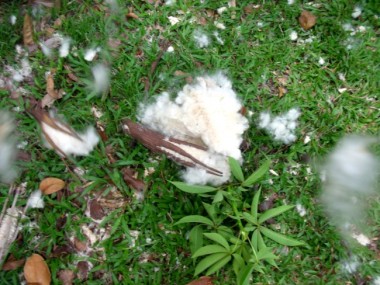
Fallen pods (actually fruits)
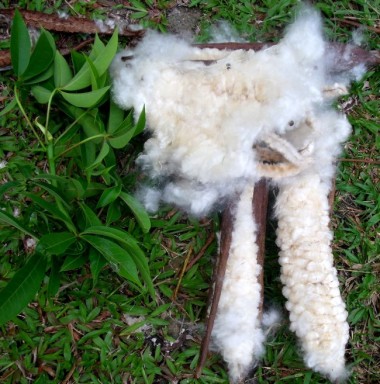
Close up of pods, the fluffy kapok fibre, and leaves.
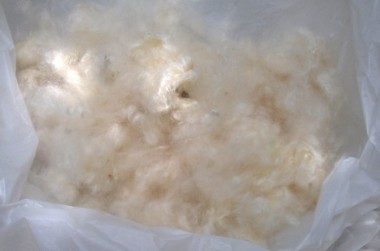
The fibre that will be used to stuff the pillows.
Isn't it time to reintroduce these fibres? They were replaced by cheap material made from petrochemicals. It may be the time now to start bringing these fibres back using modern technology to treat them to last longer etc. A kapok tree can remain productive for 500 years; how's that for sustainability!.
At the farm, we are constantly looking for material found in nature to use and to reuse.
15:10 Posted in Sustainable Farming, Useful Plants | Permalink | Comments (0) | Tags: kapok, ceiba pentandra, sustainable farming, sustainable forestry, income generating forest trees
Feb 17, 2011
Four Year Old Lempoyang ( zingiber zerumbet )
These are four to five year old lempoyang from our farm. You can call Suria if you wish to purchase them:
Farm manager, Haji Razaly with a bunch of 4 year old lempoyang rhizomes
Younger rhizomes (above picture) similar to those sold in the markets are used by us for replanting. Older rhizomes are used by us for health supplementation purposes.
Here's a research paper on the anti-inflammatory effect of lempoyang :
http://www.ukm.my/rsenr3/rsenr1/P516-520.pdf
The aqueous extract is as effective as reference NSAIDs.
We use the lempoyang as part of our anti-inflammation diet at a dosage of 5 to 10 grams twice a week.
Here's a Bernama report on the effects of lempoyang on cervical cancer:
http://web3.bernama.com/education/newsr.php?id=557690
Readers of this blog please note that the report refers to laboratory results on laboratory animals. Results on humans may differ significantly. Extracts from many plants of the ginger family have been found to have cytotoxic effects on cancer cells in the laboratory but these does not necessarily translate to a cure.
17:35 Posted in Useful Plants | Permalink | Comments (2) | Tags: lempoyang, zingiber zerumbet, cervical cancer
Jan 27, 2011
Kunyit Hitam - We hit a mother lode
We hit upon a clump of withered curcuma plants with dried yellow leaves, in the forest next to the farm. This is what we pulled out from underneath the plants; easily a kilogram :
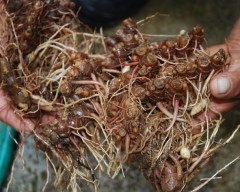
Close up with one of the rhizomes sliced opened.
click for close up
This is how you propagate the black kunyit fast. Remove the rhizomes that extend down into the soil to use, and split those above to plant.
NOTE 22/7/2012 : TWO READERS OF THIS BLOG, ONE FROM HAWAII, AND ANOTHER FROM LANGKAWI, PAK DIN, http://herbwalk-langkawi.com.my/thewalk.html HAVE IDENTIFIED THIS PLANT AS Kaempferia parviflora, A PLANT FOUND IN NORTHERN THAILAND AND USED EXTENSIVELY FOR TRADITIONAL MEDICINE. THANKS TO BOTH FOR HELPING OUT.
THE PLANT WAS FOUND IN A FOREST NEXT TO OUR FARM. WE TAKE NOTE THAT THE FOREST IN QUESTION IS BOUNDED ON THREE SIDES BY FARMS AND ON ONE SIDE BY A FOREST RESERVE. WE CAN ONLY SPECULATE HOW IT WAS INTRODUCED INTO THE FOREST, THOUGH WE MUST ADMIT IT SEEMS EXTREMELY WELL ADAPTED TO THE CONDITIONS LOCALLY AND WE HAVE NEVER SEEN ANY DISEASE AFFECTING THE SAID PLANT.
19:18 Posted in Useful Plants | Permalink | Comments (5) | Tags: black turmeric, kunyit hitam, temu hitam, kali haldi, curcuma aeruginosa, curcuma caesia
Nov 23, 2010
Useful Plants At The Farm - Patawali
Patawali is a climbing vine and can be planted wherever there's free vertical spaces
This is one of the most useful plants at the farm - patawali or tinospora crispa.
In Vietnam it is called the "vine with a genie's intelligence". In the Philippines, it is called, "to give life".
The leaves can be used as an insect repellant
At our farm, the plant has certainly given life to many an animal with indeterminate debility health problems and fevers. We have been successful with a dosage of about 0.07 grams of the stem per kg body weight for chickens and 10 grams for a goat of about 40 kg.
The stem is used for treating animals
We use this plant also as an insect repellant specifically for mites, aphids and hoppers.
To use, chop finely the leaves and spread around newly planted chillies and other vegetables to prevent insects from spreading viruses such as those that cause chilly leaf curl, at an early stage. Repeat every 5 days.
To make a spray, extract the active ingredients by fermenting the leaves and chopped stem in a solution of your own lactobacillus brew or if you don't have any, then EM is fine. After 14 days, sieve and dilute 1:500 times (can be stronger but watch out for the acidity) and spray on plants to get rid of the target insects.
A DQ discovery; as a mosquito repellent, just pound or blend some stem, filter the juice, and apply on bare skin. It has a pleasant herby aroma. Let dry and you will be mosquito free the whole night (with the possibility of reducing skin mites, and also, skin repair due to its antioxidant content). No necessity for toxic pesticides, or genetically modified mosquitoes. The juice can be kept in the fridge for weeks, making it convenient to use.
We also use this plant as an immune booster for ourselves when we feel under the weather.
(Malaysians interested in planting patawali for use as a natural mosquito repellant can write to me for cuttings for free. You pay for the postage though, or pick it up. Email us at hs_wong33@yahoo.com).
18:19 Posted in Useful Plants | Permalink | Comments (2) | Tags: patawali, tinospora crispa, tinospora rumpii, natural insect repellents, organic insecticides, organic miticides, mites, aphids, thrips, makabuhay, day than thong
Sep 04, 2010
Superfood from our forests
The latest craze in the US is black rice, touted as a superfood because of its high anthocyanin content. Here's an article from Yahoo! News.
Wait till these direct sales marketers and health food companies get hold of our black kunyit.
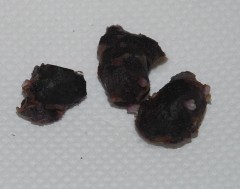

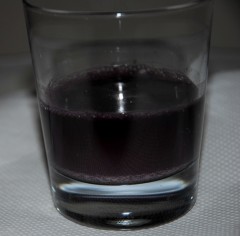
NOTE 22/7/2012 : TWO READERS OF THIS BLOG, ONE FROM HAWAII, AND ANOTHER FROM LANGKAWI, PAK DIN, http://herbwalk-langkawi.com.my/thewalk.html HAVE IDENTIFIED THIS PLANT AS Kaempferia parviflora, A PLANT FOUND IN NORTHERN THAILAND AND USED EXTENSIVELY FOR TRADITIONAL MEDICINE. THANKS TO BOTH FOR HELPING OUT.
THE PLANT WAS FOUND IN A FOREST NEXT TO OUR FARM. WE TAKE NOTE THAT THE FOREST IN QUESTION IS BOUNDED ON THREE SIDES BY FARMS AND ON ONE SIDE BY A FOREST RESERVE. WE CAN ONLY SPECULATE HOW IT WAS INTRODUCED INTO THE FOREST, THOUGH WE MUST ADMIT IT SEEMS EXTREMELY WELL ADAPTED TO THE CONDITIONS LOCALLY AND WE HAVE NEVER SEEN ANY DISEASE AFFECTING THE SAID PLANT.
11:04 Posted in Useful Plants | Permalink | Comments (2) | Tags: black turmeric, kunyit hitam, temu hitam, kali haldi, curcuma aeruginosa, curcuma caesia
Aug 17, 2010
Kacip Fatimah Propagation
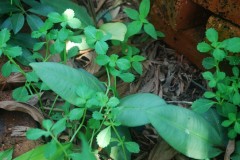


20:06 Posted in Useful Plants | Permalink | Comments (0) | Tags: kacip fatimah, labisia pumila, leave cuttings, petiole cuttings, propagation by leaf cutting
Jul 26, 2010
Useful Plants At The Farm- Mulberry Tree
The mulberry tree (morus alba; pokok daun ulat sutera; chinese: sang shu ) has a long history ( 3000 years ) of medicinal use in China, Korea and Japan.
Sinseh Soon from Raub came to the farm for a 'look-see' and told us about the medicinal uses of the tree, under which he was resting.

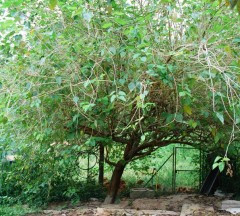

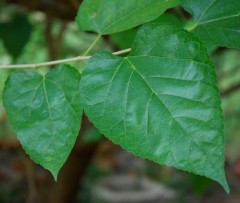

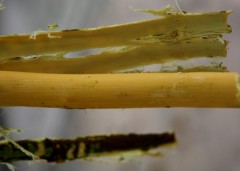

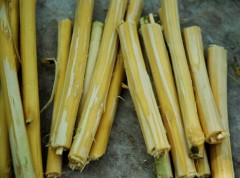

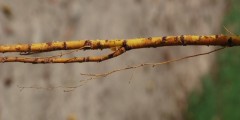
12:03 Posted in Useful Plants | Permalink | Comments (2) | Tags: mulberry, morus alba, goji, jujube, red dates, sinus, rheumatism








